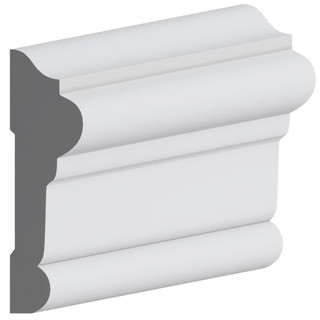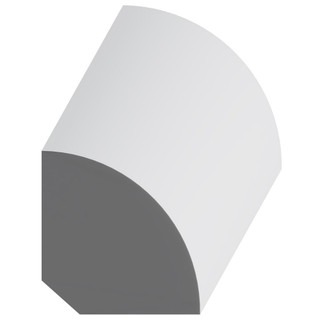Types of Mouldings and Millwork: A Glossary of Terms Designers Should Know
27th May 2025
“Mouldings” and “millwork” are two terms that both refer to decorative woodwork or “trim.”
While mouldings can be functional, they’re not structural. For example, window casings are a type of functional moulding that’s used to cover imperfections around the window frame. However, they can also add aesthetic appeal to the room. Like other types of millwork, casings can be both functional and decorative.
With so many beautiful styles and varieties to choose from, selecting mouldings can be confusing. The job is easier when you understand the different terms used for common types of trim.

Quarter Round
Quarter round is one of the most commonly used pieces of millwork. As the name suggests, a piece of quarter round looks like the result of a round dowel being cut lengthwise into four equal pieces. It’s used on its own or in combination with other mouldings to create something more elaborate.
Quarter round is sometimes confused with shoe moulding because it is often used to cover gaps between the floor and the bottom of the baseboard. However, true shoe moulding is taller than it is deep. The depth and width measurements of quarter round are always equal.
Baseboard
The millwork at the bottom of a wall is known as a baseboard. Baseboards originally protected walls from the damage caused by moving furniture around, as well as other activities. Today, it is largely considered a decorative element.
Baseboards are usually around 3 to 5 inches tall, but shorter or taller trim can enhance a specific design aesthetic.
Chair Rail
Chair railing is another type of moulding that was originally used to protect walls from nicks and scratches. It is often found in dining rooms where frequently moving chairs back and forth could cause damage at chair height.
Chair rail can be highly decorative or flat. It is often used when restoring a historic property, but modern designers and homeowners appreciate the visual appeal that chair rail adds to a space.
Casing
Casing is used around doors and windows to hide gaps between the frame and the drywall. There are many categories of casing, including fluted and reeded, colonial, and stepped designs. Casings can have mitered corners or be used in combination with corner blocks.
Door and window casings create an attractive frame that complements your personal decor style.
Crown
Also known as “crown moulding,” this type of millwork is used at the top of the wall to cover the transition joint between the wall and ceiling. This type of trim creates a “crown” that serves as an architectural feature in a room.
Crown is similar to cornices, which are used on a building’s exterior. It is often ornate with intricate designs and is most commonly used in traditional and formal spaces or to cover the transition above kitchen cabinets and other built-ins.
Picture Rail
Picture rail was once a common feature in most homes. While decorative, this type of millwork serves a function. Before the invention of temporary hooks, picture rails were used to hang pictures from. Ribbons or wire were used to hang framed images to hooks inserted into the rail. This practice prevented damage to the plaster walls.
Picture rail is typically placed close to the ceiling under crown moulding and may be mistaken as part of the crown.
Batten
Board-and-batten siding, or simply batten, is a type of wood paneling. The joints of the panels are hidden by a flat wooden strip called strapping. It is a less expensive version of wainscotting that provides the same type of textural interest.
Batten is most commonly used in modern farmhouse design, but it also looks chic and updated with crisp white or neutral gray paint.
Wainscotting
Wainscotting is a type of wood paneling found in historical homes. A combination of mouldings, including wood panels and chair rail, was used to protect the lower half of fragile plaster walls from the damage of daily living.
Many types of moulding can be used to create modern versions of wainscoting. Crown moulding, baseboards, and even casing can be combined for a one-of-a-kind look.
Scribe
Scribe is trim moulding used to cover the gap between a cabinet and the wall or ceiling. It is considered “informal” trim and is more functional than aesthetic. Scribe is typically flat and without design. It is made to blend in, not stand out.
While not impressive on its own, scribe serves an important purpose in the world of mouldings and adds polish to a project.
Cove
Cove moulding is concave-shaped and typically used for crown. It is considered less formal than traditional crown moulding.
Placing cove at the top of kitchen cabinets, bookcases, or other tall pieces of furniture can give them a more substantial, built-in appearance. Cove may also be used on a stairway to trim the transition where the riser meets the tread.
Popular Designs
Some moulding styles are so popular, they are known simply by the design name. Egg-and-dart, dentil, and bead are among the most common examples. In these cases, the names don’t describe the function, but the look of the millwork. For instance, you could find door casing or crown moulding in the egg-and-dart design.
Egg-and-dart moulding combines oval egg-like shapes with V-like darts. Dentil moulding is a repeating pattern of evenly spaced blocks that somewhat resemble teeth. Both egg-and-dart and dentil mouldings are found in Classical and Neoclassical style architecture.
Bead moulding is a repeated pattern of rounded convex shapes. Pearl moulding is also popular and very similar to bead trim. Both designs are used for creating chair rails, crown, and other trim work.
Choose Your Mouldings Carefully
Mouldings can turn a plain room into an aesthetic masterpiece, but they can also overwhelm a space if overused. To create a more cohesive look, be clear on your design style before selecting mouldings. The pros at Moulding One are happy to help. Contact us to learn more about our services and the products we carry.









